
The Westview School Blog
Cooking Up Connections: The Magic of Family Time in the Kitchen
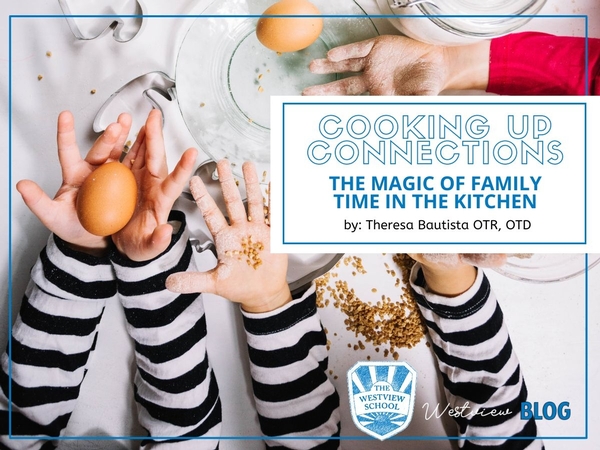
Parents are often looking for recommendations for fun family activities that could enrich their child’s life. Often, the best options can be found right at home.
Have you ever thought about involving your child in the kitchen? Activities such as preparing dinner, making a snack, or trying out a new recipe together can be a great start!
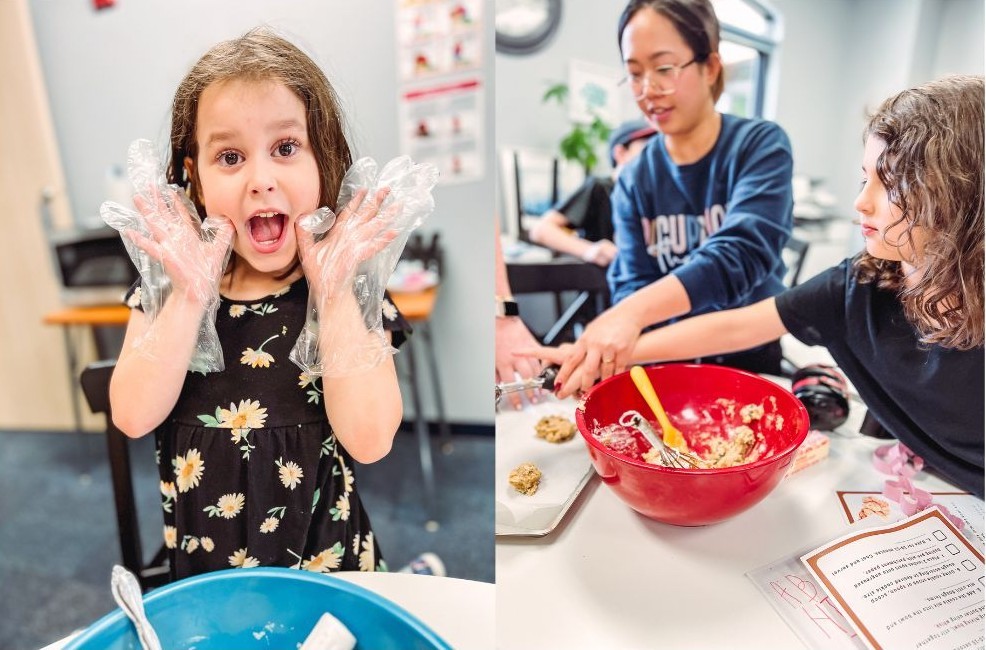
Cooking Skills and MORE
We all know that cooking teaches essential skills like measuring ingredients, following the sequence of steps in a recipe, and using various kitchen tools and equipment. Cooking provides an opportunity for children to learn how to handle utensils, chop vegetables, and stir batter. However, cooking offers far more than just the ability for your child to prepare meals for themselves and the family.
The kitchen is also an excellent place for sensory exploration – touching sticky textures (like dough) and experiencing various temperatures. Children with sensitivities to touch, taste, and smell, including those often described as "picky eaters," can benefit from this exposure, provided it allows them to explore at their own pace. This multi-sensory experience can expand their palate or help accommodate their specific support needs. For example, they may discover that wearing gloves can help their ability to handle certain textures.
The kitchen is not just a place for culinary adventures, it's also a classroom for safety. It's a perfect setting to teach children about the importance of being aware of extreme temperatures, sharp objects, breakables, and heavy items.
If you have concerns about kitchen safety, rest assured that there are kid-friendly tools like knives and scissors, non-slip cutting boards, and step stools available. You can gradually introduce them to heated tools, based on your and your child’s comfort level. This is also a great opportunity to demonstrate how to safely use the oven, stove, or air fryer.
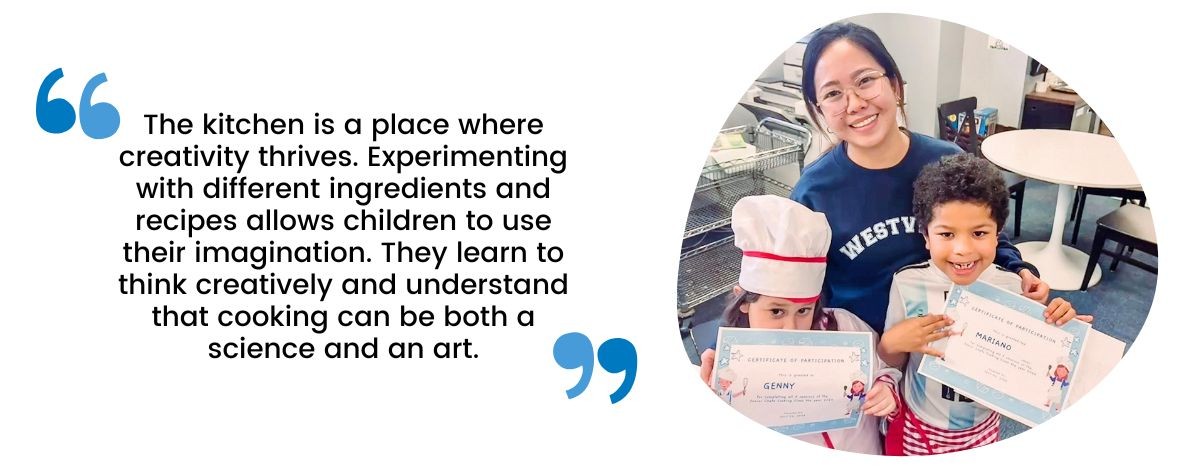
The Beauty of Cooking at Home
One of the best things about cooking with your kids in the kitchen is that you can make this a space for them to explore, make mistakes, and learn in a safe and familiar environment. When things get messy, spills happen, hands get sticky, or something breaks accidentally, allowing them to experience the natural consequences, teaches cause and effect. Initially, holding back immediate corrective feedback and allowing them to do it themselves allows them to learn and adjust. This approach builds their confidence and kitchen skills and reinforces your role as a trusted adult they can rely on for guidance.
These moments in the kitchen become cherished family stories, offering a chance to share the joy of creating something. Children witness firsthand how to communicate and how cooperation leads to a delicious end product. When families cook together, they learn to work as a team.
As children grow more comfortable in the kitchen, they gain independence. Learning to prepare meals for themselves is an essential life skill throughout their lifespan. The confidence they earn from these experiences extends beyond the kitchen and may contribute to overall self-esteem. If cooking is an accessible skill for your child, there are benefits to starting early and introducing them to the kitchen, especially if this is an area of interest.
By making cooking a shared family activity, you not only impart essential life skills to your children but also create a nurturing environment. So, roll up your sleeves, grab those aprons, and enjoy the many rewards of cooking together!
---
Theresa is a Registered Occupational Therapist with experience working with children, youth, and adults with neurological differences in the private school, clinic, and community settings. She received her Doctorate Degree in Occupational Therapy from The University of Texas Medical Branch at Galveston. Prior to becoming an occupational therapist, she worked in the field of Applied Behavior Analysis as a Registered Behavior Technician. She is also a writer and consultant who offers her specialized knowledge to websites and companies serving the neurodiverse community.
Making a Language Connection: Gestalt Language Processing in Autism
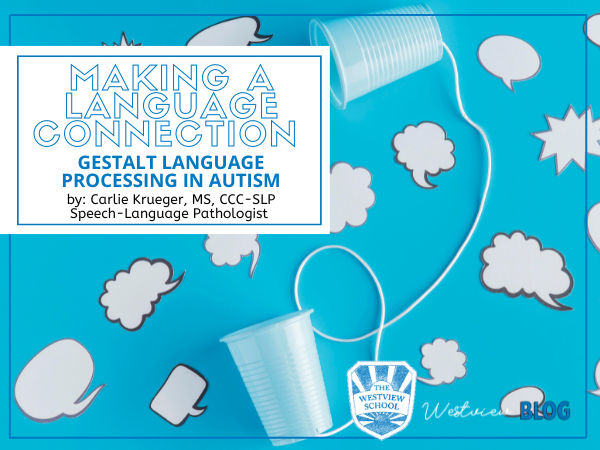
Language is a foundational tool for human connection, but how it's acquired and processed can vary greatly. For individuals on the autism spectrum, language development can sometimes follow a distinctive route called Gestalt Language Processing (GLP). One of the key features of GLP is echolalia—repeating phrases or language chunks they've previously heard. This behavior, sometimes misunderstood as meaningless repetition, actually plays a significant role in language learning. Understanding the nuances of GLP and echolalia can open up new ways to support those with unique communication needs.
What is Gestalt Language Processing?
Gestalt Language Processing is a way of learning and using language where individuals process larger language segments, such as phrases or sentences, rather than focusing on individual words. This approach is grounded in Gestalt psychology, which suggests that our minds perceive things as whole units rather than isolated pieces. For many neurotypical children, language starts with single words and gradually builds into more complex sentences. In contrast, Gestalt language processors often begin by learning language in chunks—phrases they've heard in TV shows, songs, or daily conversations. These segments are memorized and repeated verbatim as the initial step in their language journey. Over time, they learn to break down these chunks and use them flexibly to create novel sentences.
The Role of Echolalia in Gestalt Language Processing
Echolalia, the repetition of previously heard words, phrases, or sounds, is often observed in early GLP language stages, particularly among autistic individuals. There are two primary forms of echolalia: immediate and delayed. Immediate echolalia involves the instant repetition of recently heard phrases, often as a way of processing language or mirroring the emotions conveyed in the interaction. For instance, if someone asks, "Do you want to go outside?" an individual might respond by repeating, "Do you want to go outside?" instead of directly answering. Delayed echolalia, on the other hand, occurs when phrases heard in the past—sometimes days or weeks earlier—are recalled and repeated. This is commonly referred to as scripting. These phrases might stem from movies, TV shows, or previous conversations and can be used to express emotions or communicate specific needs. For example, a child feeling overwhelmed might say, "Let it go!" echoing a familiar Disney lyric to signal their need for a break.
Echolalia as a Key Part of Language Development
Contrary to being a random or meaningless behavior, echolalia is essential to language development within GLP. Instead of focusing on single words, individuals initially store entire phrases as building blocks for language. Through repetition, they start to understand social cues and language patterns. Eventually, they begin to manipulate these stored phrases, breaking them down into individual words and allowing them to construct unique sentences.
Echolalia serves several roles: it helps individuals learn the rhythm and structure of language, allows them to express emotions and experiences that resonate deeply, and sets the foundation for more flexible, self-generated language. For example, a child who frequently says, "It's time to go to bed," might eventually repurpose the word "bed" in new sentences, like "I want my bed," demonstrating growing independence in their language use.
The Connection to Autism: Why Autistic Individuals Often Use Echolalia
Echolalia is especially common among autistic individuals, who frequently use it as a primary method of communication early on. There are several reasons for this. Autistic learners often have an exceptional ability to recognize patterns, and language chunks can serve as familiar patterns they can recall and apply in specific contexts. Additionally, many autistic individuals experience heightened sensory awareness, which may cause them to focus on the tonal and rhythmic aspects of language over individual words. This focus on auditory "wholes" makes echolalia an effective tool for processing language patterns.
Socially, echolalia can bridge the gap between an autistic individual's inner world and the expectations of the social world. By repeating phrases they've heard, they are engaging with language in a way that allows them to participate in social interactions, even if it doesn't follow traditional conversational norms.
Supporting Echolalia and Language Development
When viewed through the lens of GLP, echolalia is not a behavior that needs "correction" but rather a meaningful stage in language development. For those who work with or care for individuals using echolalia, there are several ways to support their language journey.
Acknowledging echolalia as a valid form of communication is essential. Rather than dismissing repeated phrases as meaningless, it's helpful to consider them within the context of the individual's emotions, needs, or attempts to participate in conversations. Providing varied, emotionally engaging language experiences can enrich the language they're absorbing and increase the variety of phrases they can use over time. Patience is key in supporting their language development; each individual progresses at their own pace, and allowing them the freedom to navigate language in a way that feels natural to them is crucial.
Conclusion
Gestalt Language Processing provides an invaluable perspective on how some autistic individuals develop language, highlighting the significance of echolalia as a natural part of that process. For those who process language gestaltically, echolalia is a bridge from memorized phrases to flexible, self-generated language, where each stage supports the next.
Understanding GLP and the role of echolalia allows us to see language development as a spectrum of unique pathways, each worth supporting and celebrating. Embracing this approach not only provides effective support but also empowers individuals to communicate in ways that feel authentic to them, fostering genuine connection and self-expression.
References
Blanc, M. (2012). Natural language acquisition on the autism spectrum: The journey from echolalia to self-generated language. Communication Development Center, Inc.
Peters, A. (1983, 2021). The units of language acquisition. Cambridge University Press.
Prizant, B. (1982). Gestalt language and gestalt processing in autism. Topics in Language Disorders, 3(1), 16-23.
Carlie Krueger, MS, CCC-SLP is a Speech-Language Pathologist at The Stewart Center at The Westview School. She graduated Summa Cum Laude from Utah State University with a B.S. in Communicative Disorders and Deaf Education and obtained her M.S. in Communication Sciences and Disorders from New York University. She strives to practice within a neurodiversity-affirming framework that centers self-advocacy and authenticity for her clients. Carlie has been working full-time as an SLP at The Stewart Center at The Westview School since 2022. If you or your family are interested in learning more about the services The Stewart Center provides, visit us online at The Stewart Center.
Memories of Our Mother: A History of The Westview School

To commemorate the fortieth anniversary of The Westview School, the sons of founder, Jane Stewart shared a personal reflection of their early memories of The Westview School and what the legacy of 40 years of Westview means to their family.
A little over forty years ago our mother, Jane Stewart, brought us (Joey, Alan and Steven) all together in the family room and told us she was starting a school for children with disabilities. She had been volunteering at The Briarwood School for a few years and a group of parents came to her and asked if she would consider teaching their children privately. These parents recognized our mother's compassion and love for all children.
Overjoyed that Jane could now offer personal attention and schooling to a population in need of facilities, she turned our “game room” into a school during the day. We have many wonderful memories of coming home from school and watching our mother teaching and caring for her students. Often, we would join our mother rather than playing video games. That time was always very special to us. The parents were ecstatic, and the children made remarkable progress during the time they were with our mother in our home. In fact, one of our mother's first students, whose doctor told her parents she couldn't be helped, years later not only graduated from high school but was also prom queen. Our mother knew that amazing things were in all of us.
After a long discussion, our mother and father, Joel Stewart, decided to purchase a small house on Westview Drive in the Spring Branch area of Houston to expand the school, its facilities, and number of students. The Westview School was born as was the beginning of one of the most successful and ground-breaking schools for children on the autism spectrum in the country. This was a defining moment for our mother, one which filled our family with pride and love. The growth of the school meant so much to her.
As The Westview School evolved, so did our involvement as a family. Alongside our mother was our father, who not only gave his generous support to the school but also brought with him his financial and regulatory acumen. Additionally, throughout high school, we volunteered our summers working various jobs doing maintenance, painting, and building on the school grounds. The most rewarding was when we volunteered as teachers' aids, running with the children on the playground, helping with art projects, singing Heads, Shoulders, Knees, and Toes, and even happily laughing and getting soaked with the students on the slip and slide. These are the types of experiences that are so memorable and special to us.
The expansion of the school to its current location on Kersten Drive was one of the most incredible experiences of our lives. We were honored to have the late Barbara Bush preside over the opening ceremony. She graciously spent time with the students and recognized the importance of the school. This was an experience we will never forget. Most importantly, there would be a much larger school that could accommodate the growing population and could offer even more benefits to the students including a robust multidisciplinary team. Our mother made sure there was a small student-teacher ratio so that the current students received the same personal attention as her first students received in our game room.
The school expanded once again and added another building offering even more opportunities to students. Throughout the forty years, there have been many talented and brilliant individuals who have worked at the school and served on the Board to turn the school into what it is today. We are grateful that the school and staff have committed to the mission of our mom in providing a nurturing and positive environment. The teachers and the entire staff are dedicated and caring individuals. We continue to be impressed by the incredible work and enjoy watching the school and the students thrive.
Throughout our lives, we always felt that our mother was a miracle worker, and it really showed when she worked with children. Her caring, gentle and intelligent approach, based in love for each and every student, showed through at all times.
---
Joey Stewart is a feature film producer and restaurateur that lives in Dallas with his wife Laura, an interior designer.
Alan Stewart is happy to coordinate marketing and VIP programs for music, wine and NFL clients including Duran Duran, Matt & Kim, Westport Rivers Winery, and the Indianapolis Colts. He lives on a farm on the coast of Maine with his wife Lisa who is in the legal field.
Steve Stewart is a physician and Chief Medical Officer of a hospital in New Mexico and lives in Albuquerque with his wife Amy, a lawyer, and their two sons, Wells and Flynn.
The Kids Are Alright: Words of Wisdom from Special Needs Siblings

It has been said that you spend more time with your siblings than anyone else. It is one of the most formative and longest-lasting relationships a person will have. It is estimated that by age 11, siblings have spent more than 33% of their spare time together. When one of those siblings is on the autism spectrum, it is possible that the amount of time together may not differ, but the sibling dynamics certainly could.
Big sisters become little mothers. Big brothers become protectors. Younger siblings learn to be helpers. When a sibling is diagnosed on the autism spectrum, older and younger siblings tag along to therapy appointments and commutes to special schools. They become aware of differences between themselves and their siblings very early on. However, the differences and awareness that come from having a special needs sibling can often positively influence both the neurotypical child and the child with special needs.
Despite the dynamic shift, when children on the autism spectrum have a sibling in the home, it has been shown to positively affect the special needs child. Neurotypical siblings can provide increased opportunities for social skills in the home and serve as role models to siblings with special needs.
But, what about the sibling without a disability? Having a brother or a sister with special needs, in a way, can be pretty similar to having a typically developing sibling. There are the expected challenges among siblings – bickering, rivalry, learning to share, but overall, siblings of children with a disability, including autism, have a great capacity to be highly empathetic, compassionate, tolerant, and responsive to the need of others.
The Westview School blog interviewed several Westview staffers who all arrived in a special education career after growing up with a sibling with special needs. We asked them to share their experiences, how it shaped them as adults, and advice on the positive impact having a sibling with specials needs has had on their life and career in special education. We hope that by sharing their stories of growing up with a special needs sibling, our families may see the positive influences a sibling with special needs can bring to your child’s life.
Caelyn Pho is a Pre-kindergarten teaching assistant at The Westview School. She is the oldest of seven siblings. Caelyn’s youngest sister, Meagan (13), was diagnosed on the autism spectrum at four years old.
“I was twelve when my sister was born,” said Caelyn. “She was not diagnosed early, so I do hold a little bit of guilt, especially since working here. I realized how much more she struggled because of the delay.”
“I come from a very traditional Vietnamese family. Our culture's instinct is to protect,” said Caelyn. “It was more challenging during her younger years before our family learned the skills and strategies to be able to properly deal with her tantrums or other challenges.”
Lexi Doré is a Kindergarten teaching assistant at The Westview School. She is the only sister among four brothers, three older brothers and one younger. The two brothers closest to Lexi’s age are twins, Dalton and Dylan (24), and were born with cerebral palsy. Lexi’s younger brother Bouxdie (11), affectionately called Boux, was diagnosed on the autism spectrum at two years old.
“We got a pretty concrete answer that Boux was on the spectrum when he was two. He wasn’t talking, and he had a lot of food sensitivity.” Lexi remembers the early years of speech therapy and occupational therapy.
Jared Dawkins is the Upper Elementary and Middle School science teacher at The Westview School. He is the middle child of three siblings. His younger brother, Jacob (20), was born with Down Syndrome.
Jared’s experience with special needs started years before his brother was born. “My dad had a cousin, Kevin, with Down Syndrome, so we were very familiar with it already,” Jared said. “From a young age, we were taught that Kevin was different, but he was still part of this family, and we should treat him the same as every other family member.” Jared learned about his brother’s diagnosis before Jacob’s birth. “My mom knew before Jacob was born, and I remember being told that he was going to be like Kevin,” said Jared.
How has having a sibling with special needs positively impacted your life?
Caelyn: I know that Meagan has influenced me and made me more empathetic and compassionate, and understanding to people who do have challenges. Because of my experience with Meagan, I never hesitate to reach out if I see somebody struggling. I never mind helping. Without judgment, there is just a simple, “Oh, you look like you need help.”
Lexi: I have always been an empathetic person with a big heart, but I think that all stems from my special needs siblings. As I’ve grown older, it has become more of a part of me, and it is something I pride myself on, being empathetic towards others. I know how it feels like to be different, and I try my best to accommodate people in how they want to be treated. Because of my experience, I pass that thinking on to my friends and everyone around me. They are just like everyone else.
Jared: Language is a huge issue for my brother, Jacob. He is twenty now, and his language is far less advanced than anyone he communicates with. Communicating with Jacob was learned through sibling dynamics. It comes second nature to our family. This ability to communicate is one skill that has served me well at Westview. Some of our kids seem unapproachable, but I find it very easy to get through to them and understand them.
How did growing up with a sibling with special needs lead you to a career in special education?
Caelyn: My sister is the absolute reason that I started working with this population. If it were not for her, I would not have found my passion, and I will be forever grateful to her. I feel bad for my friends who are miserable at their jobs, and I get to walk in every day, make a huge impact, and love it. That is all thanks to Meagan.
Lexi: I have always had a heart for people with special needs because of my older brothers, but especially when Boux came into my life. I was already volunteering at camps for children with CP. Knowing Boux and how beautiful his mind is and interacting with his classmates on field trips, I wanted to interact with more kids on the spectrum because they are so different, but they are all beautiful and unique. I just wanted to see life through their eyes, and being more hands-on with them is the best opportunity for that.
Jared: After finishing my undergrad degree in English Literature, I enrolled in Texas Teachers to earn my alternative teacher certification. One of the school counselors recommended special education “to boost my resume.” Westview was a perfect fit. I am still learning how to be a teacher, but one thing I didn’t have to learn how to do was learn how to approach and interact with our students. It can be challenging to find people who can interact with our kids in a meaningful and genuine way, and I had that experience already.
What advice would you give to siblings of children with special needs that you have learned from your family’s experience?
Caelyn: There was always a heightened sense of awareness that my sister was different when we were out in public. I was uncomfortable having an audience during an already stressful moment. As a young girl, this would make me angry when I noticed other people minding our business. As I have matured, I have learned to channel that negative energy into help and support for my family and sister. They are what matters.
Lexi: My best advice is, ‘Give yourself the love that you give to others.’ It is important to recognize that it is okay to focus on yourself sometimes, and I am learning this more and more as I get older. You don’t have to feel guilty for taking care of yourself and your needs. Help your sibling. Help your parents as much as you can but be patient with yourself and treat yourself like you treat your siblings.
Jared: It's essential to treat a special needs sibling as normal as possible. It is the only way I know how to interact with people with special needs, be patient and considerate of their particular needs, and treat them as typical as I can. For example, one thing I'll do is if we tell a joke in a family setting, my brother will ask what was said. His language may hinder him from fully understanding the joke in the same way, but just him receiving that information makes him feel like part of the group. In my experience, it's better for me, and my brother enjoys it more when we include him in the game.
What do you love the most about your siblings?
Caelyn: Spoken language can be challenging for Meagan, but she can sing a whole Frozen song without thinking about it. We are a very musically inclined family, so there is lots of singing and dancing for every family get-together, and Meagan is the star of the show. Meagan will start singing along, and she loves to dance. For this reason, she has become one of the pillars of our family just by being there. She reminds all of us to be in the moment. When we get together, we are all pulled in and connected.
Lexi: Boux wins over everyone that he meets. All my friends have this love for Boux. He is just the best person ever. He’s my best friend. Boux is one of the brightest, smartest, coolest people I know. Even though he is not able to convey through words that he loves me, the look on his face, when I walk into a room, I know that I am his best friend too. He teaches all of us that you don’t need words to express how much you love. Love goes beyond words.
Jared: His love for my dogs. I know Jacob loves me. He asks about me when I’m gone, and he likes to hang out with me. I do not doubt how much I mean to him, but my dogs mean more. We have a blast when I come over, and he will want to hang out with me, but if I show up without the dogs, his first question is, ‘where’s Sam?’ I am always second to the dogs.
The Westview School’s mission is to provide a unique, specialized learning environment offering outstanding educational and social opportunities for children on the autism spectrum. We believe that children with autism spectrum disorder can grow and learn through a nurturing, positive, and happy environment that enhances their self-esteem. This is attainable for our students because of the dedication of our faculty and staff. The Westview team is comprised of seventy members, each of whom was led to our special school for varying reasons with a similar underlying theme — a love and passion for the children on the autism spectrum and a willingness to make a difference in the life of a child. For Caelyn, Lexi and Jared, this experience is a bit more personal, and our school is better because we have them as part of our staff.
The Experts' Guide to Picky Eaters

Are mealtimes a battle? Does your child have a limited food repertoire or only eat one brand of food? Desperately seeking tips for a successful family mealtime? The Stewart Center has some Picky Eater experts on staff to share their favorite tips and best practices from hands-on experience working with some of the pickiest eaters and their families.
The first question many families ask is: Who can help? Eating is a multisensory experience. As adults, we forget the many factors involved in eating because it is such a routine task for most of us, but eating is a surprisingly complex process. Both speech and occupational therapists can play an essential role in supporting positive change in even the pickiest of eaters.
Abby Cook, M.S. OTR, and Alexandra (Ali) Nevins, M.S., CCC-SLP are part of The Westview School's Stewart Center team and are trained in the S.O.S. Approach to Feeding®. This approach is a sensory-based feeding intervention that moves students through a hierarchy of exercises designed to increase tolerance of various foods. The S.O.S. Approach to Feeding® was developed by Dr. Kay Toomey over 30 years ago. Her program has a high success rate in the diversification of diets of picky eaters.
Because eating uses every sensory system, from visual and tactile to vestibular and interoception, a multisensory approach to feeding therapy is the start to a recipe for success. Pun intended. The Stewart Center therapists are trained in evaluation and assessments and the facilitation of individual and group feeding therapy.
When it comes to feeding therapy, a speech therapist, like Ms. Ali, can assess and support the development of a child's oral motor and feeding skills, mechanisms of chewing and swallowing, oral motor structure as well as protecting the airway during the swallow, biting, and chewing phases of eating.
An occupational therapist (OT), like Ms. Abby, can help to develop a child's fine motor skills and coordination needed to move food from plate or hand-to-mouth. Skills such as grasping, utensil use, postural control, and musculoskeletal strength for positioning during eating are necessary for successful feeding. An O.T. can also observe and assess environmental factors, modify or make changes to support optimal focus and attention to eating. Both speech and occupational therapists will consider all of these factors when working with children with food aversions to identify how to best help an individual child.
Today, we want to offer some quick tips that you can implement at home now. When dealing with a picky eater, it is essential to examine three things – the environment, language, and behaviors we model. Start with a quick check by asking yourself these questions:
- Is there a smell or taste that is overwhelming or underwhelming to your child?
- Is the environment overstimulating?
- Is there background noise during mealtimes, such as television or music?
- Does your child have the opportunity to watch a sibling or parent eat and model typical feeding behaviors?
- Can your child manipulate a utensil successfully?
- Do you find yourself saying two more bites, and then you can go (i.e., play, watch tv, or play the IPad).
Try these tips to skip those mealtime battles and help your kiddo expand their palate and self-feeding skills.
Set Up for Success: Check Your ENVIRONMENT
- Seating tops the list of important environmental factors for a successful mealtime. Think 90-90-90. Hips, knees, and elbows should be at 90-degree angles while seated for eating. Stick to a sturdy chair or highchair at the table.
- Provide appropriately sized utensils at mealtime, and use fun phrases to initiate utensil use during mealtime like "Catch the food on the fork."
- Keep food portions small – especially with new foods. The new color, smell, or texture may be overwhelming! Always provide at least one familiar food item for your child to eat. Make sure to have some new options to try exploring, but a safe food should be just that - one that feels "safe."
- Keep regular mealtime routines to lower stress and keep expectations clear for everyone.
- Have your child throw away their uneaten food items in the trash. This gets them one step closer to interacting with food, even if it is to throw it away.
- Limit both visual and audible distractions during mealtime. Television, music, and iPad can detract from your child's ability to observe typical eating and self-feeding.
- Model it! Eat meals together as much as possible. Children need to see visual models of typical eating behaviors.
Hungry for LANGUAGE. While your focus may be on what should be going in your child's mouth, what comes out of yours matters just as much.
It might be time to flip the script if you have said one of the following to your picky eater: "Clean your plate." "You have to take two bites to leave the table." "Good job eating that." "Finish your food before (i.e., T.V. or Dessert)." These phrases can unwittingly up the anxiety during mealtime.
Instead, use some alternate words/phrases that keep mealtime stress-free and fun.
- In response to, "I'm not going to eat that!" ask, "What can you do with the cheese stick?" It helps to give an example: "Can you make a mustache or wiggle it like a wobbly worm?"
- "What can you catch on your fork?"
- "Does that food have a big flavor?"
-Encourage your child to say, "I'm still learning about that." instead of "I don't like that!"
Your mother may have said, "Don't play with your food!" but when it comes to a picky eater, it might be time to change your BEHAVIOR around eating.
- Model eating and be PLAYFUL! Make food fun! Make it ok to "play" with your food. Parents can model food interactions that go beyond simply eating; encourage play during mealtime. Some examples of play can include: placing food on body parts, making a noodle into a worm, using crackers to build a sandwich, digging for gems in jello or pudding, and using food as a mustache or a long tongue.
- Avoid forcing your child to take a bite or a drink of something. This sets up an unwinnable power struggle.
- Avoid tricking your child with foods or beverages. As therapists and parents, we need to build and maintain a child's trust-related to food and drinks. When we "sneak" a new vegetable or drink into a familiar dish or a preferred cup, it can disrupt trust and turn a child off from a preferred food altogether.
We hope that these tips help you gain confidence and avoid some pitfalls at mealtime with your picky eater. If you want to learn more about Individual or Group Feeding therapy, please reach out to The Stewart Center. Our team is passionate about working with our picky eaters, supporting their families, and having fun with food.
If you are interested in learning more, contact The Stewart Center at 713-973-1830.
Additional Resources:
Instagram:
@kids.eat.in.color
@sosapproachtofeeding
@solidstarts
Websites and free resources:
sosapproachtofeeding.com/start-here-parents/
www.solidstarts.com
Parent & Caregiver Workshop (Free Full parent workshop video)
Learn from Dr. Toomey (the founder of the SOS Approach to Feeding) about why children don’t eat well and practical strategies for improving mealtimes in your home through the introductory video “When Children Won’t Eat (and how to help!).
--
Alexandra (Ali) Nevins, M.S., CCC-SLP is a Licensed Speech-Language Pathologist with the Texas Department of Licensing and Regulation and obtained a Certificate of Clinical Competence through the American Speech-Language-Hearing Association. Ali completed her Bachelor of Applied Science Degree from The University of Mississippi and received a Masters of Science in 2018 from Yeshiva University at The Katz School. In New York City, Ali worked as a clinical extern in the school system as well as at New York Neurogenic Speech-Language Pathology, P.C. Ali has been working full-time as an SLP at The Stewart Center at The Westview School since 2018. She has received continuing education training in SOS Approach to Feeding ® and Social Thinking ®.
Abby Cook, M.S., OTR is a Licensed Occupational Therapist with the Texas Board of Occupational Therapy Examiners and obtained certification through the National Board for Certification in Occupational Therapy. Abby completed her Bachelor of Arts degree in Psychology and Family Studies at St. Olaf College in Minnesota, and received a Master’s of Science in Occupational Therapy from the University of New England in Portland, Maine in 2017. Once in the Houston area, Abby started her OT career in Early Childhood Intervention for Brazoria County and has been full-time with the Stewart Center at The Westview School since 2018. Her continuing education training includes SOS Approach to Feeding ® and introductory coursework in The DIR/Floortime Approach®.
Key Ingredients to a Successful Early Childhood Development Program
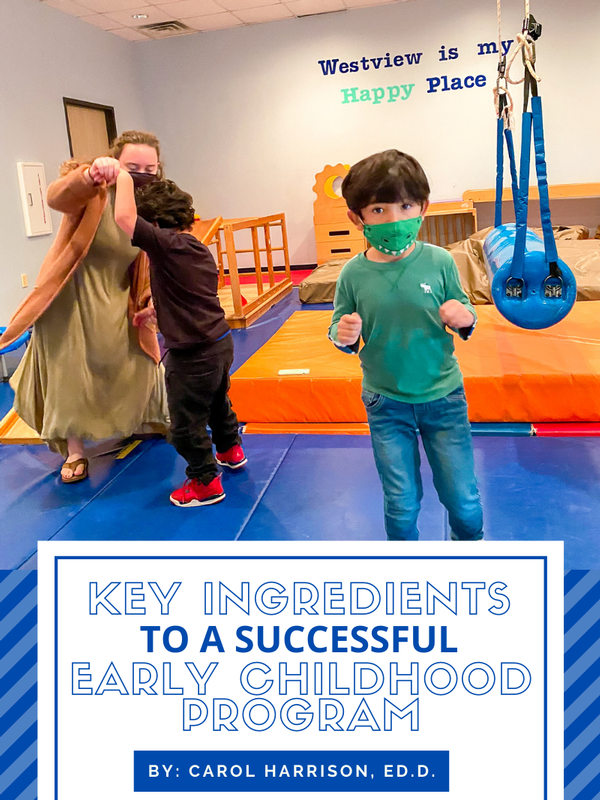
When Grayson Garcia first walked into The Westview School at the age of three, his parents would have described him as grumpy, agitated, easily upset, and angry all the time. He had minimal language, and outside of his parents and brothers, he did not connect well with others. A lengthy evaluation process and an autism spectrum disorder (ASD) diagnosis led the Garcia family to The Westview School. After a tour of the campus, the Garcias had hope that Westview would be a fit for their son.
Joni Garcia, Grayson's mom, remembers the day she brought Grayson in for a visit in the Early Childhood Development (ECD) class. "Grayson took two steps into the lobby and stopped," Joni recalled. "He looked at me, and then down the long hallway, and then over to the reception desk where Ms. Candi sat. Grayson threw himself on the floor and began to scream and cry."
At Grayson's initial reaction to the visit, Joni felt her hope start to fade, but what happened next is just one reason why Westview is an answer to so many children and families.
"Ms. Candi stepped out from behind her desk, grabbed a wagon parked in the hallway, rolled it over to Grayson, and with ZERO emotion said, 'well, if you wanted to ride in the wagon Grayson, all you had to do is say so.' Grayson immediately stopped crying and just stared at her, and then without a word, hopped in her wagon and was rolled down the hallway."
That interaction began three years of a nurturing and supportive education at the Westview School that prepared Grayson to transition to a special education program in a public school and eventually into a mainstream general education class.
So, what is it about The Westview School that helped Grayson become a mainstream success story? When it comes to early intervention for ASD children, what are the key ingredients for a successful Early Childhood Education Program that families should look for?
1. A strong early childhood program will have teachers and staff with experience and training in connecting with children with ASD. Traditional daycare programs are loving, safe environments that ensure basic needs such as feeding and changing are met, but many times the teachers don't have the training or experience to know how to connect with children with ASD. Joni realized on her first day at The Westview School that it was less about Grayson connecting but more about someone else being able to connect with him and speak his language.
2. A low student to teacher ratio ensures that each child gets the individual attention and support they need. Limiting class sizes to a maximum of five students with a teacher and assistant ensure fewer distractions and more opportunities for student participation in lessons. Also, smaller groups allow teachers to differentiate instruction, engage with each student, and better facilitate student to student interaction.
3. Effective ECD teaching should be based on research-based methodologies and strategies. Young children with ASD need a program designed to develop self-regulation, attending skills, and joint attention. Strategies for Teaching based on Autism Research (the STAR program) is a research-validated program that includes guided lesson plans, teaching materials, data systems, and a curriculum-based assessment in six curricular areas.
The STAR Program uses curriculum-based assessments to identify performance levels for each student, based on a scope and sequence of developmentally appropriate skills. Assessments are used to track and report student progress and identify instructional skills to be targeted for instruction. Children are engaged in high-interest, thematic units. As students learn how to self-regulate and attend, they are ready to work on pre-academic skills such as letter and number recognition, one-to-one correspondence, sorting, colors, shapes, and basic math vocabulary.
4. The development of communication skills is a core component of a strong ECD program. Emphasis is placed on expanding and contextualizing language within social interactions. Both expressive language abilities (labeling, describing, and comparing/contrasting) and receptive language abilities (identifying, matching, and sorting) are a focus of effective early childhood programs. Skilled teachers use a variety of structured activities to encourage and elicit spoken language. With a scaffolded approach to language acquisition, children learn to follow directions, complete tasks, and work in small groups within their environment.
5. Teacher facilitated social interaction is essential in ECD classrooms. In the most effective classrooms, teachers devise developmentally appropriate play situations to teach students how to play and interact with others. Peer relationships and appropriate social skills are acquired through guided play and interactive group games and activities. Students engage in various teacher-facilitated activities, such as pretend play, storytelling, role-playing, social routines (birthday parties, Halloween, etc.), and floor play to encourage group participation and interaction. Focus is directed toward exposing children to experiences that lead to a greater understanding of social expectations.
6. A focus on fostering self-help and independence should be a part of any strong ECD program. Self-help skills such as eating/drinking, dressing, and cleaning up play areas are intentionally incorporated into the daily schedule. Toilet training may be part of the daily routine. Children should be given the opportunity to make choices throughout the day and encouraged to become more independent. Using visual schedules helps students become more independent during transitions, restroom time, and other daily skills and activities.
Over two decades of autism research have shown that early diagnosis of autism spectrum disorder (ASD) combined with the prompt, evidence-based, and effective intervention will result in the best possible prognosis for children with ASD.
Research also indicates that in an appropriate educational setting, early intervention for at least two years before the start of primary school can result in significant improvements in language acquisition, motor development, academic achievement, social skills, daily living skills and also promotes independence in children.
Grayson is now in third grade. According to his parents, he is thriving in a general education classroom with 22 other typical kids. Grayson still has autism, but his diagnosis does not define him because of his success in the Westview School's early education.
Accepting students as early as 24 months, the Westview School proudly offers a high-quality early childhood program using research-based methodologies and strategies. If you would like to learn more about our early childhood program at The Westview School, visit our website or contact Carol Harrison, Ed.D.
If you think The Westview School could be a fit for your child, join us for our next Informational Session. The event includes discussions with our Admissions Director, Becky Mattis, about the student experience and program deliverables. Current parents will also be present to offer perspective and answer questions.
Register Here
--
Dr. Harrison brings a wealth of knowledge and experience to The Westview School following an extensive career as an educator and administrator. She served as an elementary school principal and special education administrator for 25 years in the public school system and later taught as a professor at Stephen F. Austin University. She holds a Doctorate in education.
8 Reasons to Try Art Therapy

Why Art Therapy for Autism Spectrum Disorder?
Art Therapy offers the opportunity to learn and practice many social and emotional awareness skills that are a struggle for children on the Autism Spectrum. Self-expression and maintaining and developing relationships are explored and enhanced through both the therapeutic relationship and art therapy. This is because the relationship established between a client and the therapist can promote healthy and safe attachments. The art-making component builds on that relationship and offers an alternative form of communication, sensory integration, self-expression, and promotes cognitive-emotional development.
8 Reasons to Try Art Therapy for Your Child with Autism Spectrum Disorder:
1. Imagination/Abstract Thinking
Art therapy can help your child display age-appropriate imagination and abstract thinking skills.
2. Sensory Regulation & Integration
Art therapy can improve your child's ability to regulate his or her body and integrate sensory experiences.
3. Emotions/self-expression
Children learn to use art to externalize and process thoughts and feelings, improving communication and connection between children and their caregivers.
4. Developmental Growth
Art therapy helps children hit important milestones like age-appropriate drawing ability, fine motor skills, overall artistic development, and can be used to improve other relevant deficit areas that can be addressed using art.
5. Visual-Spatial Skills
Art therapy improves the child's ability to negotiate and render/model in both two and three-dimensional spaces and the ability to rotate objects mentally.
6. Recreation/Leisure Skills
Art therapy helps children on the spectrum develop productive, enjoyable leisure activities and generalize them to the home and other natural environments.
7. Developing Self-identity/Empowerment
Using art-making can help children explore, learn, and discuss the different components of an Autism Spectrum Disorder diagnosis that empowers them to build a positive self-identity.
8. Reduce Anxiety/Stress
Art therapy also promotes learning coping skills through the creative process, including mindfulness, deep breathing, and guided imagery to improve emotional self-regulation.
How to Tell if Art Therapy is a Good Fit for Your Child:
• Does your child struggle with self-expression, relationship building, emotional regulation, abstract thinking, sensory processing deficits, or communication?
• Is your child interested in creative processes?
• As a parent, are you willing to actively participate in your child's therapeutic treatment while respecting therapeutic boundaries?
If you answered yes to the questions above, your child might benefit from art therapy.
Individual Art Therapy sessions are tailored to your child's needs. The child will lead the therapist to what materials naturally pique their interest. From there, the art therapist will create a treatment plan that includes goals and objectives. You, as the parents or caregivers, will be included as active participants in the therapeutic process.
Group Art Therapy sessions are based on a common goal. All group members will be screened to ensure they are an appropriate fit, and members will be placed according to similar developmental and emotional needs. There is a significant social and communication component to every group that children on the spectrum can benefit from. Because many individuals diagnosed with ASD are visual thinkers, artwork can facilitate forming connections with peers because it offers a concrete way to see another's perspective.
To learn more about Art Therapy at The Stewart Center, visit our website and connect with Hillery Jones.
--
Hillery Jones is a Licensed Professional Counselor and Art Therapist. Her passion is in using the creative process to help children, adolescents, and adults gain a deeper sense of self-awareness. Her approach is client-led, practical, holistic, and adaptable in everyday life. She integrates a kinesthetic learning component of connecting mind and body to her practice. She uses traditional talk therapy and art therapy to meet the unique needs of each individual. Her ultimate goal is to provide clients with the tools needed to be the best version of themselves.
Hillery received her B.A. in Art Education from Lamar University and her M.A. Art Therapy Counseling from Southern Illinois University, Edwardsville. She has worked in school, hospital, residential, and out-patient settings.
The JOY of Being an Autism Dad

Learning about Finley's Autism diagnosis at age three was overwhelming. I cried because I was scared and didn't know what it meant for Finley or our family. His whole life flashed before my eyes. Would he be ok? Would he be happy? Could he enjoy himself and his family and friends?
Finley was our first child. As I reflect on the time of his diagnosis and the years following, our world quickly became intense and stressful. Our singular focus was to get Finley everything we thought he would need to develop. The right school, the right therapists, the right activities.
When Finley was 6 or 7, I noticed that he communicated better with me (and his mom and younger brother) than he did with others. I realized that he was comfortable making eye contact with us, but not others. It became clear that the comfort of the family bond was helping him communicate better with us.
It was a lightbulb moment. I realized how important my relationship with Finley was to his development. With me, he had a "head start" and was more expressive. He gave more within our family unit than he could give to the world around him. Our relationship blossomed, and it was reciprocal. I was finally open to receive from Finley what all parents experience - the joy of seeing the world through their child's eyes. And, as our connection grew, I could clearly see how meaningful our relationship was for him. Being present and meeting him where he was socially and emotionally was me showing up for Finley in the best possible way. It was my job to give him the opportunity to have experiences and make memories when he was most comfortable and able to be himself. And this is when Finley is at his best. This is when Finley can take it all in. As a dad, watching this happen... well, it can be thrilling.
And, while I can still get anxious when I think of Finley's future, spending time with him now is something that gives me comfort and joy. And I am not near as anxious as I used to be, because I know he is well on his way to being the best person he can be.
Finley says that the weekend is "when I don't have to go to school, and you don't have to go to work." It feels great when someone else is excited to spend time with you on the weekend. So, I'm really looking forward to this weekend and spending time with Finley. We may go golfing on Saturday with his brother and grandpa. On the golf course, Finley likes to drive the cart, and I like to be his passenger.

I am proud to be part of your teacher (music) community from 2002 through 2018.
Jane was an inspiration to each and every teacher at WESTVIEW!